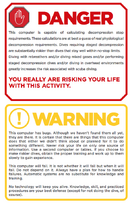- Messages
- 21,510
- Reaction score
- 21,785
- Location
- Philadelphia and Boynton Beach
- # of dives
- 2500 - 4999
Ha, and I thought nitrogen uptake was independent of breathing rate. None of the divers in the DSAT validation were as old as me, or youYeah, but we know you are weird because you don't use any air....so can't possibly uptake much nitrogen.....




